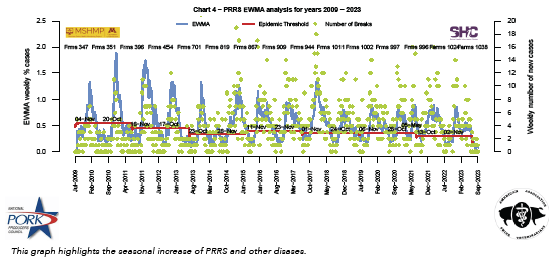Unfortunately, summer is over and the fall season is upon us, followed soon by winter. From a disease management perspective, it is also the season when major swine pathogens get a break from the sun and heat. Typically, as barns start to close up and we enter minimum ventilation rates overnight, respiratory disease is not far away.
Seasonally, the industry enters the annual epidemic phase of PRRS and other diseases between mid-October and mid-November (see PRRS EWMA analysis from SHIC’s MSHMP report).

What can be done to reduce infectious disease movement in wean-to-finish systems?
Changing this paradigm will take a commitment by producers to make an impact – it won’t be cheap, but it is costing our industry >$1B/year with some estimates as high as $1.5B.
At PIPESTONE we have implemented an ongoing wean-to-finish biosecurity survey for many of our clients and shareholders, developing a scoring system to see how they rank amongst their peers. When we analyze the results, this scorecard provides some easy-to-implement solutions that do not cost a lot of money.
What Can I Do?
Products and equipment moving into and out of wean-to-finish farms are an easy place to start. We know disinfection, time, and temperature kill viral pathogens. Have you thought of implementing Disinfection and Downtime (D&D) at your wean-to-finish farm?
A second, sometimes easy-to-implement, change is to shower in/shower out. A lot of sites I visit had showers built into them at the time of construction, however, most have never been used. We wouldn’t let someone into a sow farm without showering, what is keeping us from making this easy change?
On the difficult side, a consideration is barn location – it is difficult to pick up a farm and move it to a non-pig-dense area. Maybe renting a site in an area with a significant pig population isn’t such a great idea, or maybe your system has an option on where geographic change is possible.
A wean-to-finish barn offers ample opportunities for the improvement of biosecurity. Please reach out to any of our team members if you’d like to discuss putting these ideas to work in your operation.
 Article by Dr. Cameron Schmitt
Article by Dr. Cameron Schmitt
Dr. Cameron Schmitt was raised in central Iowa and is a second-generation large animal veterinarian. Dr. Schmitt joined PIPESTONE in 2002 after graduating from Iowa State University.
